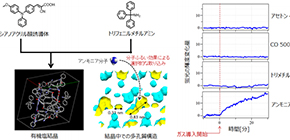
Material that can selectively detect low concentration ammonia developed
Will find applications in food security, public hygiene, and healthcare
A group of researchers led by Associate Professor Norimitsu TOHNAI from Osaka University developed a gas sensing material for detecting low concentration ammonia.
Conventionally, semiconductor gas sensors were used for detecting the presence of low-concentration gas, but their selectivity of analogous gases was poor. In this study, the group demonstrated the possibility of highly selective detection of ammonia using their unique organic crystal with a subnanoscale porous structure. This group’s achievements were presented in an oral presentation at the 68th annual meeting of The Society of Polymer Science held from May 29 through May 31, 2019.
The group has long studied porous organic crystals composed of triphenylmethylamine (TPMA), and organic acids, such as aromatic sulfonate acid and aromatic carboxylic acid. These porous organic crystals are promising candidates for functional organic materials because their cylindrical, layered, or capsule-shaped void spaces can be used for the uptake of certain chemical species.
In this study, the group developed a fluorescent porous organic crystal using a cyanoacrylate derivative as an organic acid. Capsule-like pores in the crystal acted as a “molecular sieve” to perform highly-selective adsorption of only ammonia, showing luminescence response by external stimuli. It didn’t adsorb inorganic gases (such as carbon monoxide), volatile organic matter (such as acetone), and trimethylamine, whose odor is indistinguishable from that of ammonia. The researchers also confirmed that a detection of 50 ppb ammonia was possible.
The results of their study suggest the possibility of higher accuracy ammonia measurements than conventional semiconductor gas sensors. The results will be applied to high accuracy measurements of low-level ammonia; for example, measurements of poisonous ammonia produced in laboratories and the breath ammonia level for detecting kidney and liver failure. Gas sensing using porous organic crystals will contribute to the production of new gas sensing materials that detect only targeted components.
Figure 1. (a) Porous organic crystal (b) Fluorescent responses to gases
Figure 2. (b) Fluorescent responses at various ammonia concentrations
Related links
